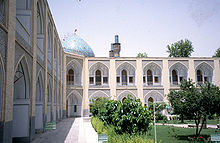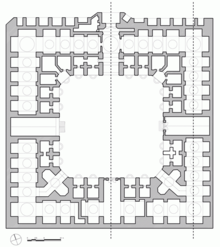caravanserai
A caravanserai (outdated spelling also caravanserai or caravanserai , from Persian كاروانسرا kārwānsarā , 'caravan yard ', Turkish kervansaray ) was a walled inn on caravan roads . Travelers could spend the night there safely with their animals and merchandise and stock up on food. Large caravanserais also served as a warehouse and trading center for imported and exported goods.
Seljuks
The word caravanserai comes from the Persian language. It is understood in most modern languages. The first caravanserais emerged in Central Asia in the late 10th century . Military fortifications increasingly took on economic and religious functions and developed into well-fortified hostels.



The Sultans of the Rum Seljuks built a network of caravanserais in Anatolia , especially in the 13th century . The distance from each other was about 30 to 40 kilometers. That corresponded to the daily workload of a caravan . In the Ottoman Empire and in Safavid Persia , the system of caravanserais was expanded. They existed from the Caucasus in the north to the Mediterranean in the south, from Lake Vrana (in today's Croatia) in the west to Afghanistan in the east. They only lost their function in the 20th century.
Caravanserais were massive fortifications with stone walls and iron-studded gates. The floor plan mostly corresponded to a square or rectangle, occasionally an octagon. They had a large courtyard surrounded by arcade -lined buildings. The ground floor housed stables for animals and shops. The quarters for the travelers were on the upper floor.
The original, Seljuk caravanserais had workshops, offered medical care, and had bathrooms, kitchens, tea and coffee shops. Music bands played for entertainment. There was a prayer room near the entrance gate. Some stations had small mosques in the courtyard. The services on the caravan routes were free of charge; fees only had to be paid in the cities. The Ottoman and Persian caravanserais were set up much more sparingly: mattresses and blankets, cookware and dishes had to be brought along.
Ottoman Empire
Smaller inns in the Ottoman sphere of influence were called Han . Hane mostly did not have a closed inner courtyard, but like the caravanserai they were two-story, so that the guest rooms were above the stables. Hane were either maintained by private operators or belonged to an Islamic foundation ( Külliye or Vakıf ). Especially in large cities like Istanbul , hane were important as a warehouse, point of sale and accommodation for non-city traders and as a place for handicrafts and trades.
Yemen
In Arabic , caravanserais are called Funduq . In Yemen today these are simple hostels for overnight stays. In the countries of the Maghreb , some of the earlier multi-storey finds, which used to be warehouses, workshops and trading places, were set up as museums or converted into hotels. Fondaco is the derived word for medieval trading centers in Venice (compare Fondaco dei Tedeschi ).
Sultanhanı , Turkey
Interior of the Sa'd al-Saltaneh caravanserai in Qazvin , Iran
The old caravanserai of Milas , Turkey
literature
- Kurt Erdmann , Hanna Erdmann: The Anatolian Karavansaray of the 13th century . Gebrüder Mann, Berlin 1976, ISBN 3-7861-2241-5 .
- Heinrich Schöttler: The Rumeljuk trade routes and their caravan arays . In: Pitty Schöttler, Heinrich Schöttler: The Rumseldschuken, founders of Turkey: History and culture . Schillinger, Freiburg im Breisgau 1995, ISBN 3-89155-145-2 .
- Wolfram Kleiss: Caravan constructions in Iran . Reimer, Berlin 1996 ISBN 3-496-02587-5 (part 1) to 2001, ISBN 3-496-02722-3 (part 6).
- Gholamreza Golmohammadi: Caravanserai in Persia: A structure on the caravan routes of Iran over the centuries . University of Hanover , dissertation , 1996 ( DNB 949734691 ).
- Klaus Stefan Freyberger : The early imperial sanctuaries of the caravan stations in the Hellenized East: evidence of a cultural conflict in the tension between two political formations . von Zabern, Mainz am Rhein 1998, ISBN 3-8053-2268-2 .





